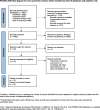Risk factors for allergic rhinitis in preschool children: a meta-analysis and systematic review
- PMID: 40775314
- PMCID: PMC12333309
- DOI: 10.1186/s12887-025-05906-z
Risk factors for allergic rhinitis in preschool children: a meta-analysis and systematic review
Abstract
Background: Allergic rhinitis (AR) is a common disease in preschool children and seriously affects their quality of life. Defining the risk factors of AR can help early diagnosis and prevention. The aim of this meta-analysis was to identify and summarizes the risk factors associated with allergic rhinitis in preschool children.
Methods: A systematic search of PubMed, Embase, Cochrane library, Web of Science, built up to 20 January 2025 was performed. Studies were included if they reported risk factors for AR in preschool children. A random-effects model was used to calculate the combined odd ratio (OR) and 95% confidence interval (CI).
Results: A total of 10 cohort studies involving 94,774 preschool children were included in this meta-analysis. The results suggested that several factors may associated with higher odds of allergic rhinitis in preschool children. These factors include parental allergic rhinitis (OR = 2.4, 95% CI: 2.01-2.87), parental eczema (OR = 1.72, 95% CI: 1.48-1.99), parental asthma (OR = 2.45, 95% CI: 1.53-3.93), male (OR = 1.54, 95% CI: 1.37-1.72), caesarean birth (OR = 1.32, 95% CI: 1.08-1.61), and dampness at home (OR = 1.24, 95% CI: 1.08-1.42). On the other hand, the presence of pets at home was found to be protective, with a reduced risk of allergic rhinitis (OR = 0.57, 95% CI: 0.41-0.78).
Conclusion: This study suggests that factors such as parental history of allergy, boys, caesarean section and damp environment at home may increase the risk of allergic rhinitis in preschool children, whereas pets may have a protective role. These findings emphasize the influence of genetic and environmental factors on allergic rhinitis in children.
Keywords: Allergic rhinitis; Meta-analysis; Preschool children; Risk factors.
© 2025. The Author(s).
Conflict of interest statement
Declarations. Ethics approval and consent to participate: Not applicable. Consent for publication: Not applicable. Competing interests: The authors declare no competing interests.
Figures








Similar articles
-
Probiotics in infants for prevention of allergic disease.Cochrane Database Syst Rev. 2025 Jun 13;6(6):CD006475. doi: 10.1002/14651858.CD006475.pub3. Cochrane Database Syst Rev. 2025. PMID: 40511642 Review.
-
Saline irrigation for allergic rhinitis.Cochrane Database Syst Rev. 2018 Jun 22;6(6):CD012597. doi: 10.1002/14651858.CD012597.pub2. Cochrane Database Syst Rev. 2018. PMID: 29932206 Free PMC article.
-
Capsaicin for non-allergic rhinitis.Cochrane Database Syst Rev. 2015 Jul 14;2015(7):CD010591. doi: 10.1002/14651858.CD010591.pub2. Cochrane Database Syst Rev. 2015. PMID: 26171907 Free PMC article.
-
Skin care interventions in infants for preventing eczema and food allergy.Cochrane Database Syst Rev. 2022 Nov 14;11(11):CD013534. doi: 10.1002/14651858.CD013534.pub3. Cochrane Database Syst Rev. 2022. PMID: 36373988 Free PMC article.
-
Polyunsaturated fatty acid supplementation in infancy for the prevention of allergy.Cochrane Database Syst Rev. 2016 Oct 28;10(10):CD010112. doi: 10.1002/14651858.CD010112.pub2. Cochrane Database Syst Rev. 2016. PMID: 27788565 Free PMC article.
References
-
- Bernstein JA, Bernstein JS, Makol R, Ward S. Allergic rhinitis: a review. JAMA. 2024;331(10):866–77. - PubMed
-
- Kong Y, Hao M, Chen A, Yi T, Yang K, Li P, et al. Symmap database and TMNP algorithm reveal Huanggui Tongqiao granules for allergic rhinitis through IFN-mediated neuroimmuno-modulation. Pharmacol Res. 2022;185:106483. - PubMed
-
- Ponda P, Carr T, Rank MA, Bousquet J. Nonallergic rhinitis, allergic rhinitis, and immunotherapy: advances in the last decade. J Allergy Clin Immunol Pract. 2023;11(1):35–42. - PubMed
Publication types
MeSH terms
Grants and funding
LinkOut - more resources
Full Text Sources
Research Materials

